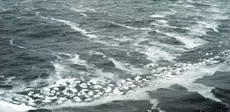Cryosphere glossary
in meteorology, a term used loosely to distinguish radiation in the visible and near-visible portions of the electromagnetic spectrum (roughly 0.4 to 4.0 microns in wavelength) from longwave (terrestrial) radiation.
a form of new ice, composed of spongy, white lumps a few cm across, that tend to form in rough seas; they resemble slushy snow balls.
Image

Antarctic Sea-Ice Processes and Climate program (ASPeCt)
an area of high pressure which forms over Siberia in winter, and which is particularly apparent on mean charts of sea-level pressure.
very old, thick sea ice that forms in fjords; it often resembles glacial ice, because snow can pile up on the ice over many years.
a passive heat transfer device, filled with either a liquid or a gas, installed to remove heat from the ground.
(1) (United States) frozen raindrops that bind on impact with the ground (2) (elsewhere) a mix of rain and snow, a mix of rain and hail, or melting snow.
mass movement of earth material down a slope; includes landslides, mudslides, debris flows, avalanches, etc; speed of movement can be sudden and catastrophic or slow.
common near the snow line on a relatively flat portion of a glacier where melting snow forms slush.
currently used as a synonym for general air pollution; it was originally created by combining the words smoke and fog.
A network of sites that measures SWE with snow pillows, as well as other variables of interest related to snow depth, weather, and soil moisture. These sites are maintained by the Natural Resources Conservation Service (NRCS), an agency within the United States Department of Agriculture (USDA).
(1) an ice particle formed by deposition of vapor in the atmosphere (2) a collection of loosely bonded ice crystals deposited from the atmosphere; high density snow (greater than 550 kilograms per cubic meter; 34 pounds per cubic foot) is called firn if it is older than one year.
a specially constructed board used to identify the surface of snow that has been recently covered by snowfall.
an arch formed by snow which has drifted aross a crevasse, forming first a cornice, and ultimately a covering which may completely obscure the opening.
a sample of snow, either just the freshly fallen snow or the combined old and new snow on the ground, obtained by pushing a cylinder down through the snow layer and extracting it.
(1) in general, the accumulation of snow on the ground surface (2) the areal extent of snow-covered ground, usually expressed as percent of total area in a given region.
the mass of snow per unit volume which is equal to the water content of snow divided by its depth.